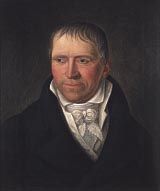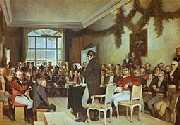A short history of the Cappelen family
By Hans Cappelen
Oslo,
2001
The
origin
Who were the first Cappelen-ancestors
? We don't know exactly today - as with
so many family names. What we do know
is that several persons by the surname von Cappelen (with some slightly
different spellings) are mentioned through the 15th and 16th centuries in
documents from the little town Wildeshausen in Northern Germany. They were craftsmen and members of the town
council and of guilds for shooting and defense. It is difficult to trace their exact lines of descent and
relations as the written sources from that time are few and scattered.
Where did the von Cappelens originally
come from ? Most likely from the little
place Cappeln (in the years 11-1200 spelt "Cappelen") some 20
km away from Wildeshausen. We don't
know if the Wildeshausen-Cappelens had any links to the medieval
"Ritter"-family von Cappelen at the castle "Haus
Cappeln" in Westerkappeln near Osnabrück, or to the prominent merchant
family von Cappeln in the city of Bremen.
The word
"von" indicates probably the local origin only, but it might
mean some kind of lord of the place Cappel(e)n. The Norwegian part of the family stopped using the
"von" in the first part of the 19th century, while in Denmark many
relatives still use it.
From
Wildeshausen to Norway
The first
proved Cappelen ancestors in Wildeshausen were the town mayor Dietrich von
Cappelen and his wife Margaretha Poppe. Dietrich died in 1632 while captured as hostage by Swedish troops
during the 30-years-war. His father was
most likely Johan v. C., living in the same street ("Langen
Viertel") and some times member of the town council. A similar position held Gerdt v. C.
one generation before, and he was either the son of or otherwise related to Hinric
v.C. who lived in Wildeshausen around 1485.
When
Dietrich died in 1632, his son Johan v. C. was only 2 1/2 years
old. As a young man he was some years
in Bremen, but in 1653 he came to Norway. His new country then had an expanding economy and foreigners with
know how were welcomed by the authorities.
Johan soon married a Norwegian girl, Bodil (Boel) Ottesdatter. Three of their sons survived them and
established family branches that still are flourishing. Johan - the immigrant to Norway- made a
career that became the pattern for the family members in the centuries to
come. Johan was first in industrial
business and trade, then a civil servant as sheriff (fogd) of Lier (near
Drammen), and he acquired real estates in Drammen and at the countryside.
The last
remaining von Cappelens in Wildeshausen died there in the 18th century.
Cappelens
in 1700 and 1800
The three
sons of Johan and Bodil were: Johan junior
(Branch I) who succeeded him as sheriff, Ulrich Friederich (Branch
II) who settled as merchant in Skien, and Gabriel (Branch III)
who was a merchant in Drammen.
Branch
I consists of
military officers, local parish priests, civil servants, medical doctors
etc. Johan jr.'s grandson Andreas
(d. 1786) was a priest in Denmark and he was the founder of the Danish
line. Of that line were several
merchants in Copenhagen and in some Danish towns. From that line also descend many Cappelens in the US (especially
in Kenosha, Wisconsin, and in Florida).
One of the Branch I priests was Peter Andreas C. (d. 1800) who
became a famous missionary to Greenland.
Another member was the well known manager of the Storting (the
parliament) administration , Johan H. C.
The Skien
branch -Branch II- has always had many members and is divided into
several family lines. Ulrich
Friderich's son Diderich (Diderik) bought some forests that ever since
have been in the possession of his direct male descendants by that same
name. They are living at Holden manor
house and are the owners of Ulefoss iron works (the "Ulefoss-line"). The well known painter August C. (d.
1852) belonged to that line and he had his childhood at Ulefoss.
The second Diderich (d. 1794) in Skien was the biggest ship owner in Norway. Many of his descendants were estate/land owners, industry and ship owners, politicians etc. ("Ulefoss- line", "Gjemsø kloster-line" and "Borgestad-line".) His son Didrich (d.1828) was a great land owner (the manors Mæla, Gjemsø kloster, Bratsberg, Borgestad, Rising, Frydendal, and many forests in the county of Telemark, etc). This Didrich was the deputy for Skien to the Constitutional Assembly at Eidsvoll in 1814.
 |
 |
|
Didrich
von Cappelen (d. 1828) - "The Eidsvoll Man" from Skien in 1814.
|
|
A separate
family line of the Skien branch is the "publisher line". It descends from Jørgen W.C. (d.
1878) who founded the publishing house with his name in Christiania (Oslo),
that was owned by the family until recently.
The first publisher Jørgen married a celebrated actress, Fredrikke
Helene Schwirtz, of Christiania Theatre. The author Peder W. C. (d. 1992) belonged to this line.
Other
lines from the Skien branch are the "younger Drammen lines"
with several merchants (Cappelen building in Drammen), industry (Eidsfoss and
Kongsberg iron works), land owners (manor houses of Austad and Vivelstad)
etc. A central person in Drammen was Peder
v. C. (d. 1837) who organized the building of the first Drammen bridge. The composer Christian C. belonged to
another of these Drammen-lines.
Branch
III starts with Gabriel
v. C. who acquired the great "noble estate" Fossesholm at Vestfossen,
so this branch is often called the Fossesholm branch of the Cappelen
family. The manor house Fossesholm is
today a museum and beautifully restored to the style and time of Gabriel's son,
the wealthy timber merchant and estate owner, Jørgen v. C.
(d.1785). He and some relatives are
mummified and they still lie in their coffins in a private and separate burial
chamber at Haug church.
While
Fossesholm went with a female line, the male lines were merchants, farmers,
ships captains, civil servants etc. in the county of Vestfold, in Bordeaux,
France, as well as in the US. The
famous engineer Fredrik C. who constructed the Cappelen Bridge in
Minneapolis, belonged to this family branch.
The wives
of all these Cappelens came from quite different families: some of Norwegian origin
and some of foreign, some were daughters of peasants and farmers, others of
craftsmen or merchants and land owners.
The
Cappelen daughters married into families as different as their mothers'
families. Quite often there were
marriages between relatives -closer or more distant ones- and often the
couples' parents were friends, business acquaintances and the like.
Cappelens
of 1900 and 2000
During
the 20th century some Cappelens have settled in other countries -as
the US, Sweden, Austria and even Germany.
In Norway the Cappelens have taken part in the rapid development
of the country as regular citizens, businessmen, civil and military servants,
lawyers, architects, artists etc.
Several Cappelens were resistance fighters during the Nazi occupation of
Norway 1940-45. One of them, Hasse
(Hans) C. (Skien branch) was much tortured and sent to concentration camps in
Germany, later being Norwegian witness at the Nurenberg War Trial. His brother (and my father) Dixe (Didrik)
C. succeeded in escaping from a Nazi-prison and death penalty.
In the
20th century many family members have been active in politics. The Norwegian prime minister Gunnar
Knudsen (d.1928) was married to Sofie C. of Branch II ("the
Borgestad line"). Members of the
King's cabinet after World War II were Johan C.S.C of Branch I, and Andreas Z. C. of
Branch II. Other members of the family
have been members of the Storting and of local councils etc.

The
family coat of arms
The
heraldic motifs of the arms are common for the entire family:
The
shield is parted in two fields, the upper one having the mother pelican feeding
it's young with it's own blood, and the lower field has the three blooming
roses with leaves and stems. On top of
the shield is a knight's helmet with a crest: two buffalo horns and between
them the symbol of
Fortune being a naked woman holding a ship's sail in her hands and standing on
an orb. (The Ulefoss-line has,
however, dropped Fortune and uses the two horns only.)
The colours
of the arms have varied through the centuries; the oldest being the 1st field
blue with silver pelican, and the 2nd field silver with red/green roses. The horns are silver, Fortune is of natural
colours but with silver sail and orb.
Above you see the arms of the Skien-branch reproduced in colour from a
drawing made by Jan Raneke, Sweden.
The drawings of the arms have followed the
changing historical styles so that we have very many different versions. But the heraldic elements have been the same
ever since 1683. It was the sons
of the immigrant to Norway who started to use the arms in seals on documents
and on a silver engraving. Their father
Johan v. C. had in his first seal the three roses only in a shield
The arms were assumed in Norway by the family
without any royal grant or the like.
This was according to Norwegian law and the family's right to the arms
was soon well established, as it was repeatedly used in seals on official
documents, on decorations in churches, on an iron grave monument, painted on
costly wagon doors etc.
We have no traces of any arms for the family in
Wildeshausen. But the very first Johan
v. C. had in 1619 a seal with an elaborate house mark in a
shield. (House marks consist of
geometrical lines only.) We don't know
any other copies of that house mark from family members.
There has been no common motto for the Cappelen
family. But Diderich v.
C. (d. 1762) at Fossesholm had a two sided signet (now in the US) and on
the one side a motto is worded
DILIGENTIA VIRUM CORONAT
which is Latin and means "Diligence crowns the
man".
Family
litterature
General:
E. A. Thomle: Familien (von) Cappelen i Norge og Danmark (Christiania, 1896)
H. Krog Steffens: Norske Slægter 1912 (Kristiania, 1912)
H. Cappelen: Familien Cappelens tyske opprinnelse - noen antagelser og hypoteser (Norsk Slektshistorisk Tidsskrift ( = NST ) vol. XXXI, p. 378
Branches and single persons:
R. Thommessen: August Cappelen og hans samtid (Kristiania, 1906)
Y. Hauge: Fra herregården og fra bruket (Oslo, 1934) (about Fossesholm)
E. Østvedt: August Cappelens brev (Oslo, 1952)
E. Boyesen: Jørgen Wrigth Cappelen 1805-1878 (Oslo, 1953)
Y. Hauge: Ulefos Jernværk 1657-1957) (Oslo, 1957)
C. Borchsenius: Cappelens Enke (NST, vol XXVI, p.8)
H.L. Tveterås: I pakt med tiden - Cappelen gjennom 150 år 1829-1979 (Oslo, 1979)
(about J.W.Cappelens Forlag |the publishing house|).
H. Cappelen: Våpensegl og slektspapirer fra Skiensdistriktet (NST, vol. XXXV, p.445)
M. Malmanger: August Cappelen (Oslo, 1997)